Telestroke Services Market Size and Trends
The telestroke services market is estimated to be valued at USD 1.99 Bn in 2025 and is expected to reach USD 5.53 Bn by 2032, growing at a compound annual growth rate (CAGR) of 15.7% from 2025 to 2032.
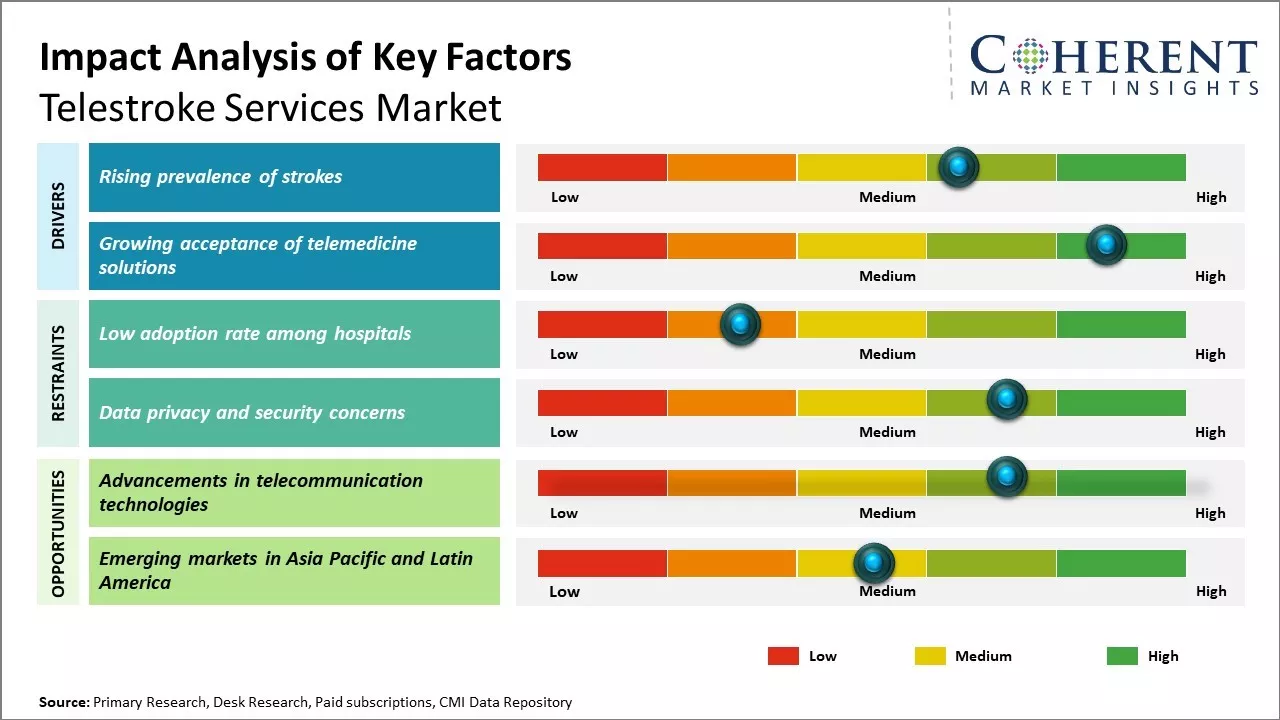
Discover market dynamics shaping the industry: Download Free Sample
Advancements in telestroke capabilities along with growing geriatric population who are at high risk of strokes are the major factors driving the estimated growth of the market. The market is witnessing increasing adoption of telestroke services to enhance stroke care in rural areas. Growing patient preference for virtual stroke consultations and guidelines by healthcare organizations recommending the use of telestroke is boosting demand for telestroke services. However, lack of awareness regarding the availability of telestroke and high cost of equipment and services in few regions may hamper the market growth.
Rising prevalence of strokes
The increasing risk of strokes globally has become a serious public health issue. Strokes are among the leading causes of disability and mortality across many developed and developing nations. The risk of strokes grows steadily with age, with the majority of stroke cases occurring among individuals over 65 years of age. With prolonged lifespans and aging populations worldwide, the number of elderly persons is projected to grow sharply in the coming decades. This will correspondingly drive up the burden of age-related health conditions like strokes. Lifestyle changes across large sections of the world's population have also inadvertently increased stroke risks over time. Unhealthy diets high in fat, sugar and sodium are widespread. Physical inactivity due to more sedentary jobs and urbanization have become commonplace. Additionally, conditions like obesity, diabetes, and hypertension which are known risk multipliers for strokes have seen rising prevalence globally. All of these factors contribute to a growing strike susceptibility at the population level.
Market Concentration and Competitive Landscape
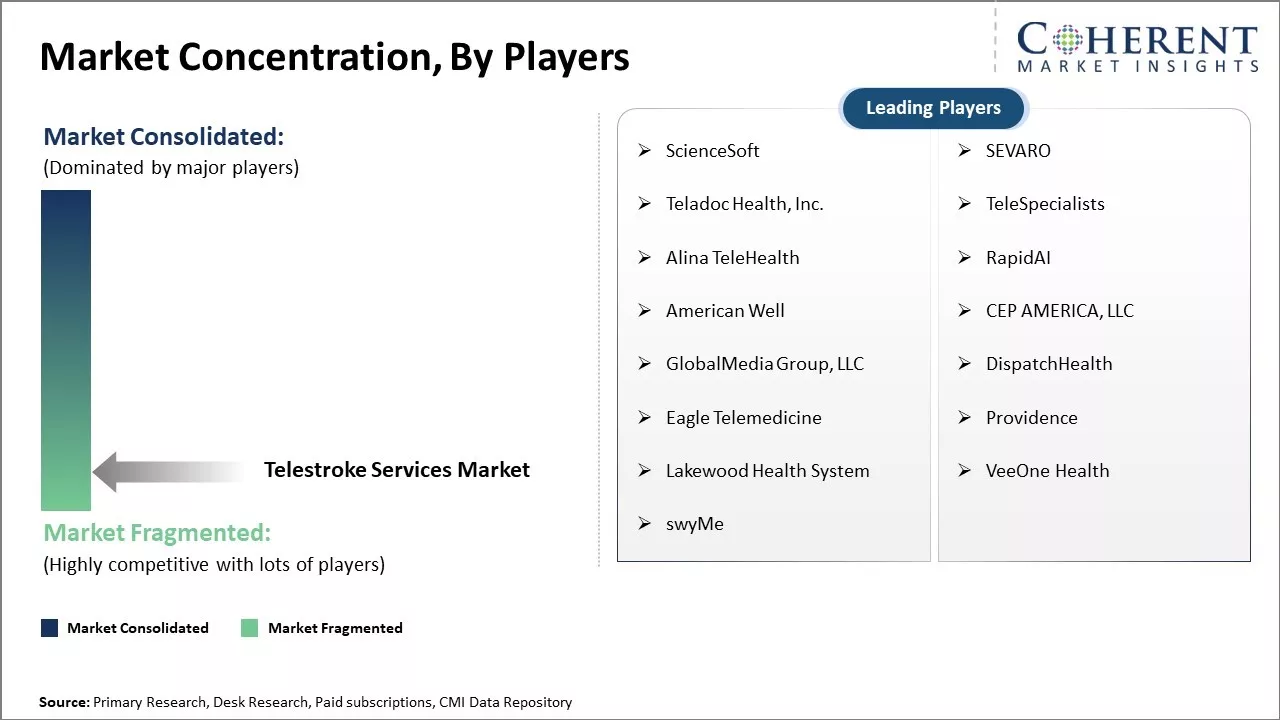
Get actionable strategies to beat competition: Download Free Sample
Growing acceptance of telemedicine solutionsTelestroke services are benefiting from the increasing comfort and familiarity of patients and physicians with various telemedicine modalities. What started as an experiment during the pandemic is fast becoming the new normal worldwide. Telehealth solutions are now being adopted across a broad spectrum of specialties from dermatology to cardiology. Stakeholders have recognized their ability to improve access to expertise, reduce travel costs and time, ensure continuity of care and aid early triage and treatment. With each successful implementation, doubts regarding reliability, and efficacy of virtual care diminish. New technologies centered on artificial intelligence, augmented reality, and remote monitoring are further fueling innovation and integration of digital health applications. The upside of telestroke networks is also being appreciated by policymakers and payers. Remote telestroke evaluations are proving equivalent or in some cases superior to onsite assessments alone. This translates to savings in indirect costs like reduced readmissions and long-term care needs. As telestroke programs mature with experience, their outcomes data strengthens the case for broader insurance cover and investments.
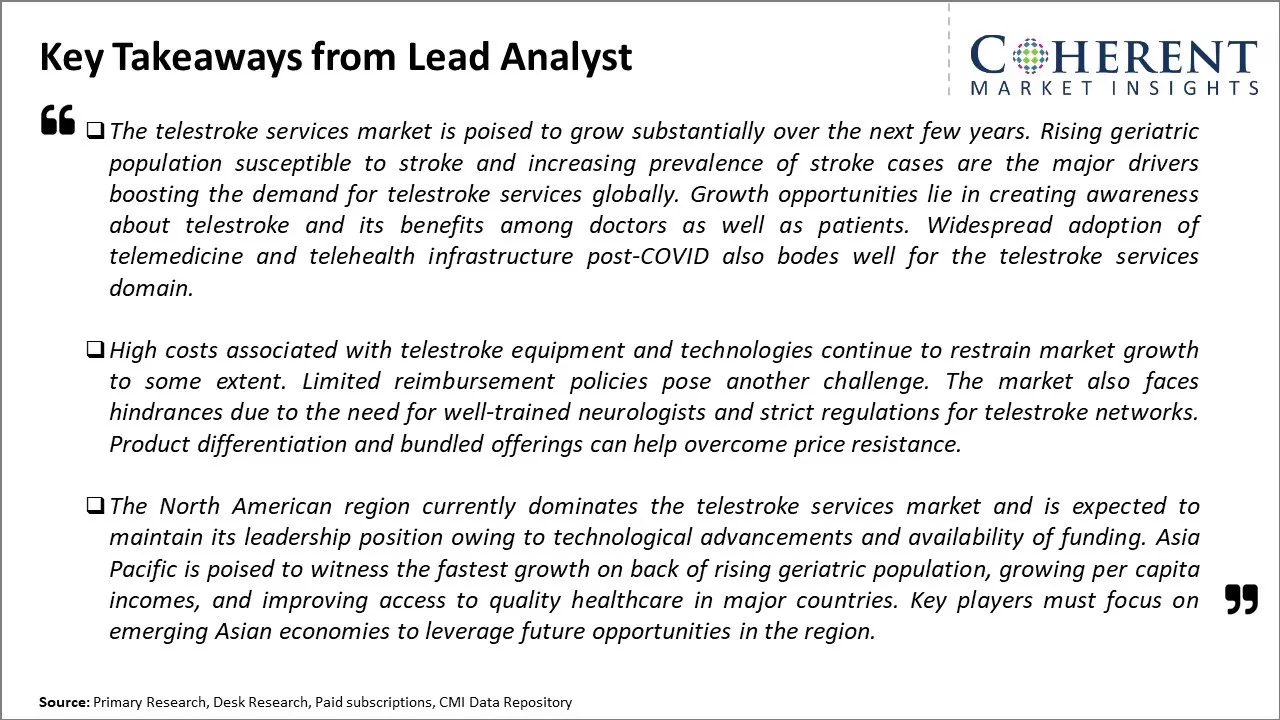
To learn more about this report, Download Free Sample
Market Challenges: Low adoption rate among hospitalsThe telestroke services market faces many challenges currently. Low adoption rate among hospitals due to budget constraints and lack of awareness is a major hindrance. Health professionals are also reluctant to change due to comfort with traditional methods. Reimbursement issues from insurance providers for telemedicine consultations act as a discouraging factor. Standardization and interoperability between telestroke platforms are needed to scale operations.
Market Opportunities: Advancements in telecommunication technologies
Rising geriatric population who are at high risk of stroke creates significant opportunities for market growth. Increasing incidence of strokes and time sensitivity of treatment are driving the need for telestroke. Advancements in telecommunication technologies are making virtual consultations more efficient. There is a push for infrastructural development in rural areas where specialty care accessibility is limited. Investments from healthcare IT players is anticipated to create lucrative growth opportunities for market over the forecasted period.
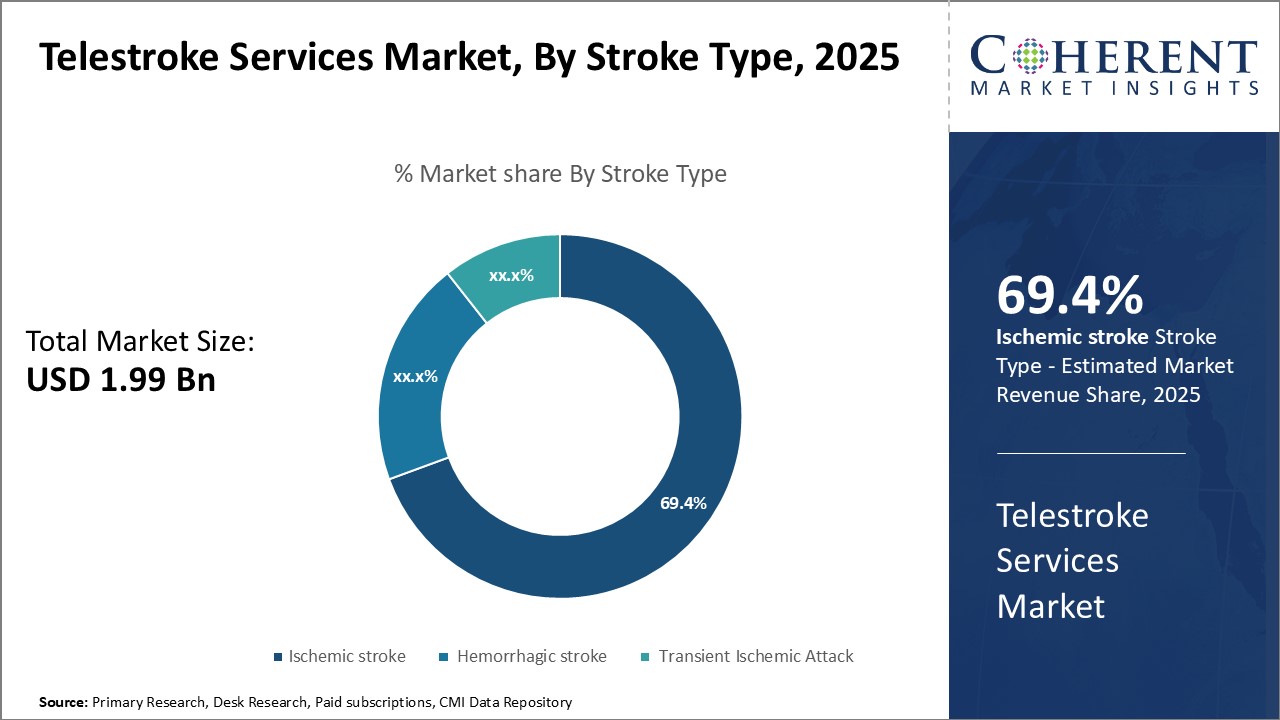
Discover high revenue pocket segments and roadmap to it: Download Free Sample
Insights, By Stroke Type: Treatment Advancements Drive the Ischemic Stroke Segment GrowthThe stroke type segment includes ischemic stroke, hemorrhagic stroke, and transient ischemic attack. Ischemic stroke segment is anticipated to hold 69.4% of the market share in 2025. Ischemic strokes are caused by a blockage that stops blood flow to the brain, such as a blood clot. Being the most common type of stroke globally, accounting for nearly 87% of all strokes, the ischemic stroke segment has received extensive focus from healthcare providers and researchers. Major drivers for the ischemic stroke segment include the rising availability of thrombolytic drugs that can dissolve blood clots and restore blood flow. Notable among these are tissue plasminogen activators (tPA) that have proven effective if administered within three to four hours of the onset of symptoms. As thrombolytics become more widely adopted in clinical practice, including in telestroke networks, they are expanding access to time-critical treatment for ischemic strokes. Another factor fueling the segment is the emergence of advanced interventional procedures like mechanical thrombectomy that uses stent retrievers and suction devices to remove large clots. Such minimally invasive techniques have significantly improved recovery outcomes when performed within six hours of symptom onset.
Insights, By Platform Deployment: Cloud-based Platforms Drive Efficiency and Access
The platform deployment segment includes cloud and on premise. Cloud segment is anticipated to contribute the highest share of the telestroke services market and is projected to hold 85.3% of the market share in 2025. Healthcare organizations are increasingly recognizing telestroke networks as a cost-effective means to expand specialty access in underserved communities. Cloud-based telestroke platforms allow hospitals to avoid large upfront infrastructure investments and focus budgets on direct patient services. They also offer scalable solutions that grow along with provider networks and patient volumes without limiting hardware or bandwidth resources. By providing a secure environment for video consultations, treatment guidance and data exchanges, cloud services are helping drive operational efficiency. For healthcare providers, the flexibility and ubiquity of cloud-based telestroke networks promote collaborative stroke management between primary, emergency, and consulting specialists separated by distance. They facilitate real-time coordination of evaluation, treatment, and transfers seamlessly across organizational and geographical boundaries. This ability to deliver equitable, integrated care has gained significance during the recent pandemic challenges.
Insights, By Application: Hospitals Lead EMR Adoption due to Heavy Patient Volumes and Need for Coordinated Care
The application segment includes counseling, treatment, emergency service, and others. Emergency service contributes the highest share of the telestroke services market and is projected to hold 41.1% of the market share in 2025. With every minute that passes without reperfusion treatment, nearly 2 million neurons are lost and the risk of permanent disability rises exponentially. Every second therefore counts once stroke symptoms appear, making telestroke networks an imperative for managing these medical emergencies in isolated communities. One of the most important uses of telestroke technology is enabling rapid neurological assessments by on-call specialists via telemedicine. They support local physicians in identifying stroke subtypes, making treatment decisions including administration of thrombolytics, and deciding on appropriate patient transfers if interventional care is required. Given the time-sensitive nature, most telestroke consultations are initiated from emergency departments or medical imaging suites. Additionally, virtual neurological consults streamline the evaluation and management of transient ischemic attack (TIA), or mini-stroke, cases presenting to emergency rooms.
Regional Insights
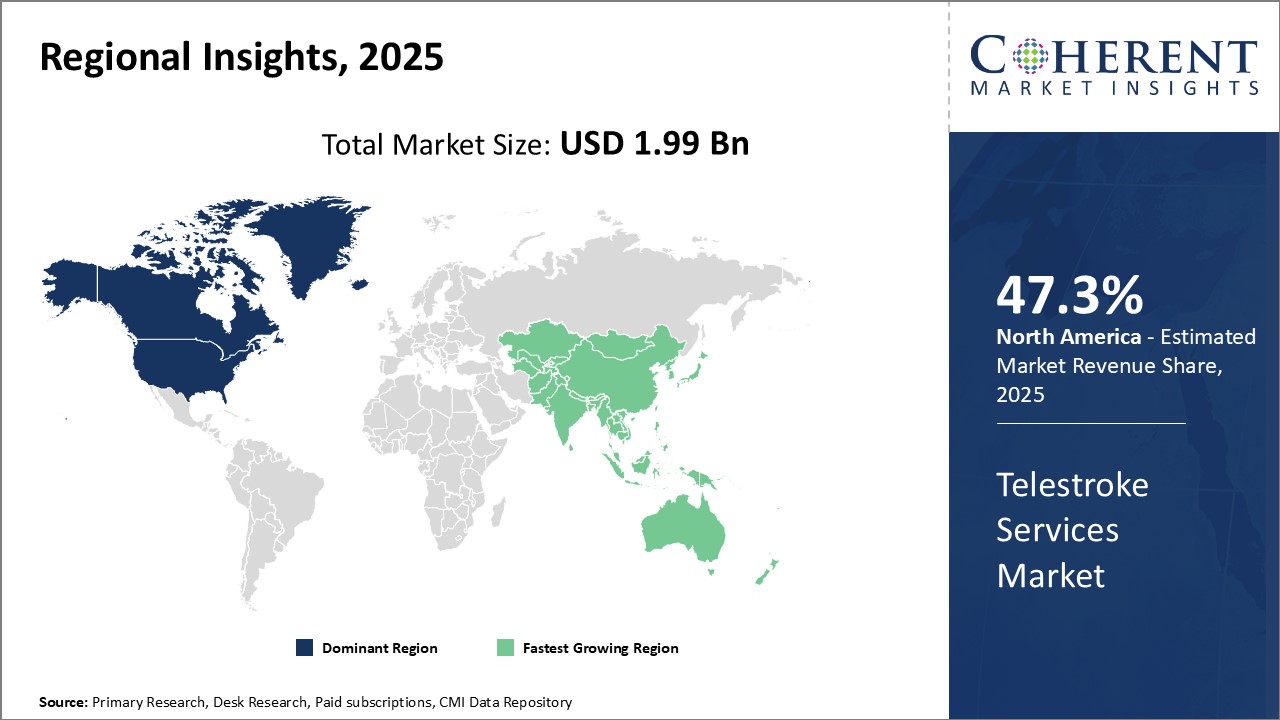
Need a Different Region or Segment? Download Free Sample
North America has dominated the global telestroke services market over the past decade and is projected to hold 47.3% of the market share in 2025. The large presence of major industry players has ensures that the region accounts for the lion's share of the global market. The U.S., in particular, has seen wide adoption of telestroke services due to supportive regulations and huge healthcare spending. Several major hospitals have implemented telestroke programs to ensure timely stroke treatment for patients in remote areas. The availability of advanced telecommunication infrastructure and high reimbursement rates have encouraged hospitals to invest in telestroke services.
The Asia Pacific region is poised to be the fastest growing market for telestroke services in the coming years. Rapid economic development and rising healthcare expenditure have increased access to advanced technologies in countries like China and India. Furthermore, the growing burden of non-communicable diseases including strokes has prompted governments to focus on improving treatment facilities. This is particularly important for vast rural regions with limited access to specialty care. The governments are actively working with international players to adopt telehealth models to address this challenge. While pricing may be relatively lower than developed markets currently, further economic gains are likely to boost spending on such critical services over time.
Market Report Scope
Telestroke Services Market Report Coverage
| Report Coverage | Details | ||
|---|---|---|---|
| Base Year: | 2024 | Market Size in 2025: | USD 1.99 Bn |
| Historical Data for: | 2020 To 2024 | Forecast Period: | 2025 To 2032 |
| Forecast Period 2025 to 2032 CAGR: | 15.7% | 2032 Value Projection: | USD 5.53 Bn |
| Geographies covered: |
|
||
| Segments covered: |
|
||
| Companies covered: |
ScienceSoft, SEVARO, Teladoc Health, Inc., TeleSpecialists, Alina TeleHealth, RapidAI, American Well, CEP AMERICA, LLC, GlobalMedia Group, LLC, DispatchHealth, Eagle Telemedicine, Providence, Lakewood Health System, VeeOne Health, and swyMe |
||
| Growth Drivers: |
|
||
| Restraints & Challenges: |
|
||
Uncover macros and micros vetted on 75+ parameters: Get instant access to report
Telestroke Services Industry News
- In November 2023, Brainomix, an Artificial Intelligence (AI)-powered medtech solutions firm, announced the debut of its full suite of U.S. Food and Drug Administration (FDA)-cleared modules in its Brainomix 360 platform for stroke care, signaling the company's continuous expansion in the U.S. The U.S. launch, which included the previously announced FDA-cleared e-ASPECTS module, is a comprehensive platform designed to support physicians and their imaging-based treatment decisions at all stages of the stroke pathway, from basic imaging to advanced imaging.
- In May 2023, TeleSpecialists, a globally recognized provider of hospital-based telemedicine solutions, is promoting stroke treatment during National Stroke Awareness Month. National Stroke Awareness Month, observed in May, strives to improve public awareness of stroke risk factors in order to reduce the occurrence of strokes across the U.S.
- In August 2022, CHA Hollywood Presbyterian Medical Center (CHA HPMC), an acute care facility, has developed telestroke services in partnership with the USC TeleStroke and Neurological Emergency Program to deliver prompt stroke assessments and improve patient care quality. This program enables CHA HPMC emergency room physicians to consult directly with Keck Medicine of USC's world-class stroke neurologists.
- In February 2022, Viz.ai, the pioneer in AI-driven intelligent care coordination, and TeleSpecialists, LLC have formed a strategic partnership to combine AI-powered stroke care with renowned telestroke neurologists to reduce time to treatment and enhance patient outcomes across the U.S. The cooperation combines the Viz Intelligent Care Coordination platform with the neurologists' experience at TeleSpecialists to revolutionize medicine by notifying providers and providing immediate access to high-fidelity imaging, patient information, and Health Insurance Portability and Accountability Act (HIPAA)-compliant
*Definition:The telestroke services market consists of virtual medical consultation and care delivery for acute stroke patients via telemedicine. Telestroke networks allow hospitals without neurological expertise to access trained stroke specialists to facilitate rapid diagnosis and treatment recommendations for time-critical conditions like strokes. Telestroke services leverage real-time audiovisual telecommunications to connect local emergency personnel with remote stroke experts, expediting treatment decisions for stroke patients. This improves patient access and outcomes while reducing time-to-treatment in emergency stroke cases.
Market Segmentation
- Stroke Type Insights (Revenue, USD BN, 2020 - 2032)
- Ischemic stroke
- Hemorrhagic stroke
- Transient Ischemic Attack
- Platform Deployment Insights (Revenue, USD BN, 2020 - 2032)
- Cloud
- On Premise
- Application Insights (Revenue, USD BN, 2020 - 2032)
- Counseling
- Treatment
- Emergency Service
- Others
- End User Insights (Revenue, USD BN, 2020 - 2032)
- Hospitals
- Specialty Clinics
- Home Healthcare Settings
- Others
- Regional Insights (Revenue, USD BN, 2020 - 2032)
- North America
- U.S.
- Canada
- Latin America
- Brazil
- Argentina
- Mexico
- Rest of Latin America
- Europe
- Germany
- U.K.
- Spain
- France
- Italy
- Russia
- Rest of Europe
- Asia Pacific
- China
- India
- Japan
- Australia
- South Korea
- ASEAN
- Rest of Asia Pacific
- Middle East
- GCC Countries
- Israel
- Rest of Middle East
- Africa
- South Africa
- North Africa
- Central Africa
- North America
- Key Players Insights
- ScienceSoft
- SEVARO
- Teladoc Health, Inc.
- TeleSpecialists
- Alina TeleHealth
- RapidAI
- American Well
- CEP AMERICA, LLC
- GlobalMedia Group, LLC
- DispatchHealth
- Eagle Telemedicine
- Providence
- Lakewood Health System
- VeeOne Health
- swyMe
Share
Share
About Author
Komal Dighe is a Management Consultant with over 8 years of experience in market research and consulting. She excels in managing and delivering high-quality insights and solutions in Health-tech Consulting reports. Her expertise encompasses conducting both primary and secondary research, effectively addressing client requirements, and excelling in market estimation and forecast. Her comprehensive approach ensures that clients receive thorough and accurate analyses, enabling them to make informed decisions and capitalize on market opportunities.
Missing comfort of reading report in your local language? Find your preferred language :
Transform your Strategy with Exclusive Trending Reports :
Frequently Asked Questions
EXISTING CLIENTELE
Joining thousands of companies around the world committed to making the Excellent Business Solutions.
View All Our Clients
